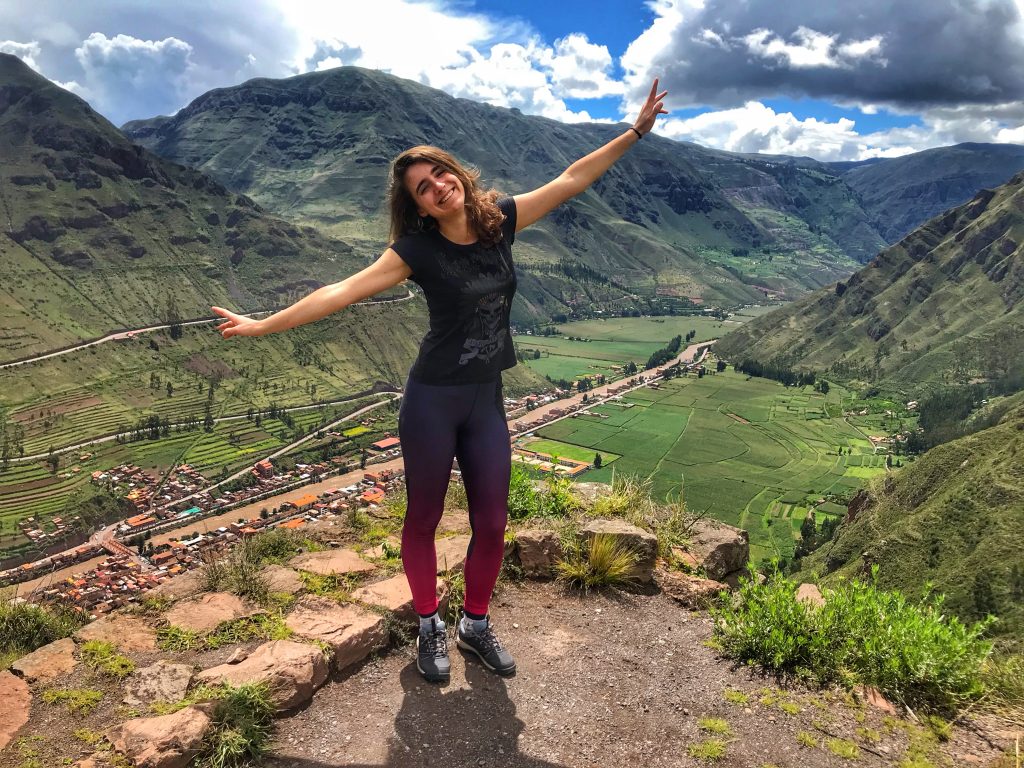
We are bouncing up and down in a local ‘collectivo’ bus, going down the mountain. I look out the window and get a glimpse of the incredible greenness and perspective of Sacred Valley. Wohooo another turn. And I start getting sick. I see the new friend I made this morning take a sniff of some green substance. She tells me it’s rapé, a mixture of Amazonian herbs that helps her ground and feel less sick on the way down. She offers me some. I hesitate a bit as I have never tried this, but I trust her. I set my intention to ground by holding the green dust close to my chest and take a sniff. It feels like someone just threw a proper blast of lemon in my brain. I can feel my body relaxing, getting lighter. Then I start getting sick again, only this time it’s not about the turns. Luckily, we get off the collectivo and within 10 minutes I feel amazing. I am looking around and I can’t believe my eyes. It’s one of the most spectacular places I’ve ever seen, there’s majestic steep green mountains in literally every direction. My heart is open and my eyes are shining with joy and awe. My new friend suggests that we go have some delicious vegan cake at her favourite cafe and chat some more about shamanism. And so my adventure in Pisac begins.
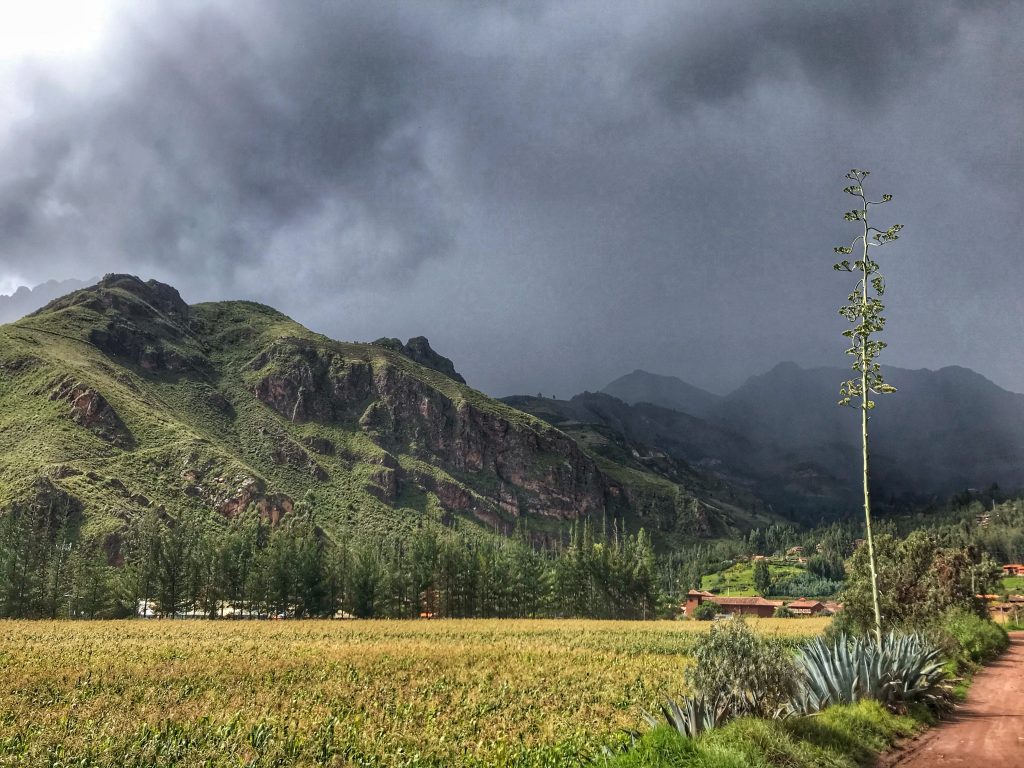
About Pisac
Situated in the Sacred Valley of the former Incan Empire, at almost 3000m above sea level, Pisac is a Peruvian village of clay houses, narrow streets and officially around 10,000 inhabitants. Tourists from the nearby city of Cusco come by for short trips to the nearby Incan ruins and the local market full of local handmade works of art and clothing. However, there is also a growing spiritual community of digital nomads, entrepreneurs, hippies, travellers, life coaches, therapists and healers. Most of them are first drawn by the lure of legal plant medicine exploration in the Sacred Valley, ’The Intergalactic Airport’. They come for anything between 1-2 weeks on one of the many plant medicine retreats and 6 months. Sometimes they end up setting up a business here and never leave. Once you see the place, you can really understand why. It’s really easy to fall in love with the incredible nature, the local culture, the peace and quiet and the opportunity to live in proximity to a vibrant spiritual community.
Why choose to come here of all places?
Everyone has their story, I can tell you mine. Many years ago, I read one of my favourite books of all time – ‘Journey to Ixtlan’ by Carlos Castaneda. It marked the beginning of my spiritual journey by showing me my concept of reality was arbitrary and subject to questioning and exploration. Then 4 years ago, I stumbled across ‘Cave and Cosmos’ by the founder of the US Foundation for Shamanic Studies Michael Harner. He suggested that shamans were not only healers in traditional cultures, but an aspect of our human psyche that allows us to access the wisdom and healing powers of the subconscious mind. Using his method, I experimented with a 20 minute drum journey. To say it blew my mind is an understatement. It showed me in a deep experiential way the vastness of ‘The Great Within’ and gave me a very practical clear way to consult its wisdom whenever I wanted to. Since then, shamanic journeying has been my main spiritual practice. It has helped me grow out of the ‘ordinary’ world of my past and create a life in line with my values of connection, love, freedom, playfulness and truth.

My view at Rinconada street, aka Gringoville, where many foreigners are staying.
For many years it’s been my dream to find a place where I can deepen my spiritual work and gain a fuller understanding of shamanism and its roots. As an online life coach and group process facilitator, I could choose to be anywhere. I just needed good internet somewhere around and a nice community to play with. I knew I had to go in Latin America, but where exactly? A friend of mine showed me the Spirit Map he had created – a visualisation of the top spiritual communities around the world based on facebook data. In it, I saw the Sacred Valley of Peru listed as No. 1 in Latin America, No. 21 in the World. Clicking through, I quickly found my way to a couple of facebook groups where I saw lots of spiritual and personal growth events, got info on local housing prices and availability etc. Lots of community buzz happening in Pisac. I was done deciding.
What has made Pisac such an incredible place to stay?

I’ve been here for more than 2 months at the time of writing this. I plan to stay for a total of 6, which is the maximum time per year allowed for foreigners who don’t have a local registered business (unless I get married to a Peruvian in the next couple of months, which is also an option in theory haha). Here’s my 5 wonders of Pisac, or my reasons for choosing to stay here, in no particular order:
1) Wonderful nature
Oh I can talk forever about how gorgeous nature here is! Temperatures in the rainy season vary between 12 and 20, making it feel like an eternal spring. It does rain quite often between December and April and the non-asphalt streets get muddy, but there’s sunshine and beautiful sunny days as well. What that means is also that everything is incredibly green and pretty. The peace and quiet stands out very strongly for people like me used to living in cities. On a clear night, the sky shines with the light of a stunning multitude of stars. It reveals the Milky Way that the Incas used to refer to as the ‘Celestial River’. They focused on the dark spots rather than the stars, recognising silhouettes of animals who came to drink (a llama, a fox, a snake, a toad).
There’s steep mountains in literally every direction, creating a very strong sense of nature’s presence wherever you go. There’s something about them that brings high level perspective and grounding at the same time. It encourages you to dream big. A great place to go walk and stare at them is the Chihuanco trail. It offers the perfect mix of magnificent views, quiet and hummingbirds buzzing around, starting at 5 minutes walk from the Pisac Market. Some beautiful day hikes include the Incan ruins above Pisac, the Huchoy Qosqo trail and the Kinsa Cocha Lake. For those willing to travel a bit more, Machu Picchu, Titicaca and the jungles of Manu National park are a day’s trip away.

Kids out to take care of the sheep and llamas at Kinsa Cocha Lake.
As wonderful as nature here is, she also has a way of inspiring respect not just through the mountains, but also through its waters – with wild and powerful Urubamba river and occasional floods. A more serious one happened in February 2020, flooding the streets and bottom floors of Pisac houses. It left them covered in mud that has taken many days and much effort to clean.

Locals cleaning up the streets of Pisac after the flood.
2) Andean culture
Most locals here live basic lives, mostly off agriculture, crafts and trade. Although foreigners are bringing some new vibes, threats and opportunities to the place, Pisacans are still deeply rooted in their culture. Most speak Quechua in addition to Spanish. Their religion combines Christianity with local Andean beliefs and customs. For instance, they call the mountains ‘apus’ and have deep respect for them. They believe they are sacred spirits that provide protection and bless the Valley with their presence. They call dozens of apus by their names on most sacred ceremonies they hold. Some examples are:
– despachos: an elaborate shamanic ceremony of making an offering to the apus and Pacha Mama to request permission to stay here;
– temazcal: rebirthing into a new phase by hanging out in a tent full of hot steam in absolute darkness for 2 hours. It’s a tradition brought here from North America from White Buffalo Woman, 19 generations ago;
– sacred medicine rituals – going out for a psychedelic experience in the mountains in a San Pedro cactus hike; sitting with Ayahuasca, etc.
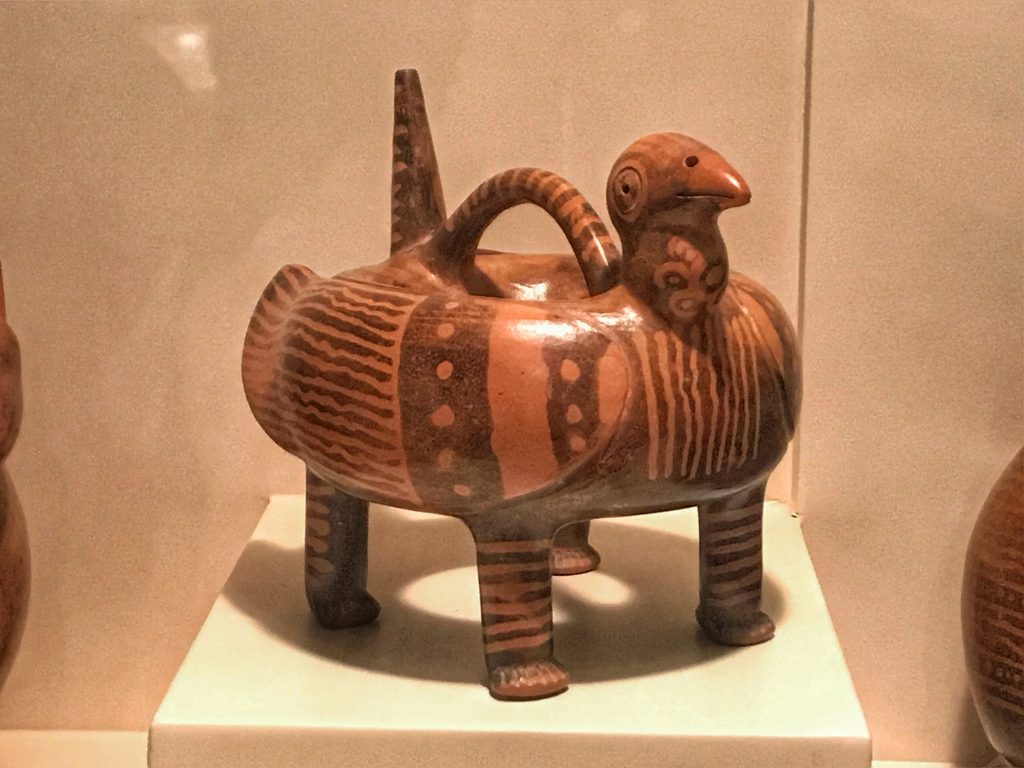
An ancient Peruvian deity with a condor’s head, a snake’s body and a puma’s legs.
The apus offer protection to the beings of the middle plane of the Andean cosmovision (represented by the puma). They also connect Pacha Mama (Mother Earth, represented by the snake) with Pacha Papa (Father Sky, represented by the condor). These characters are part of a stunning variety of symbols woven into local myth, song, culture and cloth. The local market in Pisac shows off incredible artisan works of vibrant colors that offer great examples of that. It’s visited not just by humans, but also by alpacas, whose wool is the one mostly used in the production of clothing here. There’s nothing cuter and softer in this Universe than a baby alpaca and if you are lucky, you usually find some around the market.

3) Sacred plants and plant medicine
The two main plants widely used by the locals are coca and San Pedro. For foreigners, coca is seen mostly as the salvation from altitude sickness. It also provokes their curiosity with its use in the production of cocaine and Coca Cola and its illegal status in most Western countries. Most don’t refer to it as plant medicine, because its effects are much more mild and subtle compared to other options. However, the locals have deep respect for coca and for them, it is a sacred plant. Besides making great tea and chewing material (I have a friend who ‘cocachews’ for 3 hours as his morning practice!), coca is used in many local traditions. For example, there’s coca leaf reading, coca therapy and the ‘quintu’ is used in most Andean shamanic ceremonies. Quintu is made out of three leaves of coca that you hold between your fingers and share with. One leaf to give your gratitude to Mother Earth, one to ask protection from the Apus and one in the middle to connect to your own soul.

Coca leaves and tea.
The traditional plant medicine in the valley is San Pedro (Huachuma). Obtained from the cactus of the same name, it’s a bitter yellow liquid that can keep you in alternate reality for up to 10 hours. Some people take it in centers like The Hummingbird Retreat, others opt for a nature hike with ‘huachumeros’ like Miguel and David. As one of those sensitive ones (who didn’t realise she was such), I must say going for a hike on your first go might be a bit of a stretch. It is nevertheless a deeply healing experience in which you get to watch nature both within and outside come alive in unexpected ways.
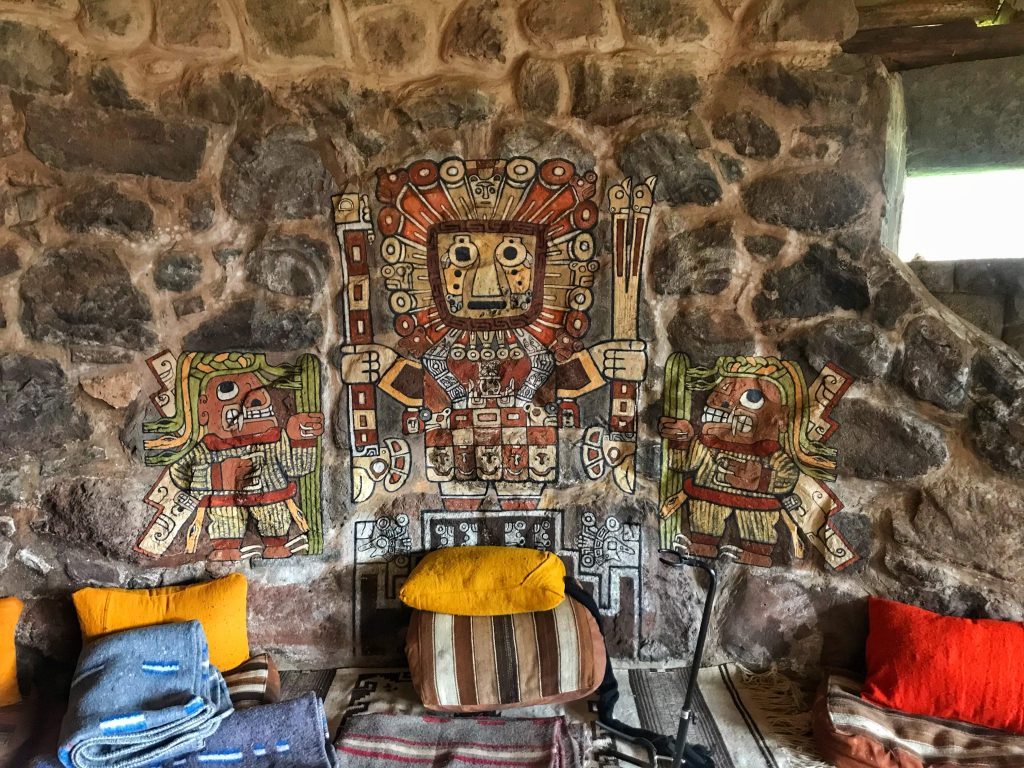
The temple at Ayahuasca Ayllu in Taray village.
Then there’s Ayahuasca – a plant medicine obtained from Amazonian vines which is not part of local Andean tradition, but still quite popular among foreigners here. On one of my first days in the Valley, we walked with some friends to the nearby village of Taray. Heading out of the village, we walked straight into Ayahuasca Ayllu – one of the few local ayahuasca centers, owned by musician, writer and shaman Alonso del Rio. The energy of the place felt really beautiful. We found out they also use part of their revenue for the creation of a school for cultural education for local kids and reforestation in the Amazon. We decided to go for a ceremony there. It was one of the most profound and beautiful experiences of my life (you can read the whole story here).
If you want to explore healing through sharing your consciousness with plants (eg. rapé, mushrooms, bobinsana etc) or frogs (kambo and bufo), you will find what you are looking for in Pisac. I am personally not a fan of random exploration. I have found that my experiences with sacred medicine are much better when I take my time and wait for the call and listen closely to my intuition about whom to do them with. One can experience so much in a single session with Ayahuasca or San Pedro – they say it often takes years for it to integrate, i.e. settle in your psyche and life. Then there’s also the so-called ‘dietas’. For deeper exploration and healing, people here recommend going for one with a shaman in the Amazonian jungle. A dieta can take anywhere from a week to 6 months. You stay in solitude, eat certain foods and every few days are given sittings of ayahuasca and another ‘masterplant’ chosen for you by the shaman. It’s a whole another beast that they say can be life-changing, but is also quite intense, definitely not for the faint-hearted.
4) Spiritual community
The Pisac spiritual community is relatively small. The biggest events, such as the weekly Kirtan (Indian mantra singing) and Maha Temple ayahuasca ceremonies are usually attended by about 60 people or so. Some of those people are travellers passing by for a week or two. Some are digital nomads or people in major transition phases who stay for several months, some call Pisac home. Besides plant medicine ceremonies, there’s yoga, breathwork, women’s and men’s circles and all kinds of spiritual and personal growth events to enjoy. This includes institutions such as Sunday Sacred Sushi lunch (where the community gathers for some tasty vegan food prepared with great care by Brian and his team). There’s also Sunday Ecstatic Dance at Alchemica, which includes cacao, a safe space to explore conscious movement and awesome music by Dawid Rakowski and others.
Cafes and restaurants have their own very important role to play in the community life. They provide us with abundant opportunities to bump into one another on a daily basis, giving fertile ground for discussions, ideas and co-creation. My favourite by far is Lily of the Valley – a small cafe, overseen by Pimiento the cat and his dog friends with the most delicious vegan cakes and some awesome teas and salad options for lunch. There’s also Ulrike’s, Hierba Buena, Cultura Viviente, the amazing pizza at Antica Osteria and at the moment of writing this – the new coworking space and restaurant that Alchemica that is just being launched.

Pimiento napping next to his new pillow at Lilly of the Valley.
5) Opportunities to serve
Almost everyone here has some private sessions or workshops to offer: plant medicine ceremonies, energy healing, coaching, movement therapy, tantra, craniosacral therapy, shamanic journeys, breathwork, qi gong, etc. At the same time, people love to learn, explore, play together, so it seems there’s always place for more.
Upon my arrival, I heard the owner of Alchemica talk about holding authentic relating. It is a form of meditation practice in relating with others that allows us witness sensations, emotions, thoughts and intuitive visions arising within as we communicate in deep and beautiful ways. I immediately got excited, as this has been one of the practices I’ve been very committed to in the last years, both as participant and space-holder. I asked if he had a facilitator and quickly became the one, hosting such gatherings with the beautiful humans of Pisac every Monday. If you are here before end of April 2020, join us.
After one of the circles, a girl who joined asked me to co-create a women’s writing circle with her and another friend. The next day, I found myself sharing my favourite embodiment practice and a powerful reflective space with a bunch of wonderful conscious women. That’s now become a regular biweekly gathering. At another circle I participated in, I shared about my work with shamanic drum journeying and within 2 days I found myself hosting a ceremony for 12 people in the home of a beautiful local soul who was just as passionate about it as I was. The list goes on and on, with opportunities popping out of every corner. For those who like me have found they have a role to play in supporting the evolution of human consciousness, Pisac offers amazing opportunities to learn, serve and co-create in alignment with that purpose.

Fire and dance ceremony at Otorongo Temple
Wrapping it up…
Whether it’s nature, culture, plant medicine, community, service or a mixture of those that initially lures you into the Sacred Valley, the truth is that for conscious travellers the reasons for coming here often go deeper and reveal themselves at their own pace during our stay here. I feel deep gratitude for the way in which this place has helped me to stay anchored in my core, giving me so much space to expand and dream and act bigger than ever before. There’s something about the energy here that keeps bringing me back into filling my place in a larger ecosystem with everything I give and receive. It helps me tune into the collective field of consciousness I share with humans and other beings alike and honour my responsibility to planet Earth in beautiful new and old ways.
As the world keeps spinning the threads of what Joanna Macy calls ‘The Great Unravelling’ of civilisation and life on earth as we know it, I believe places like Pisac are becoming the birthing place of the threads of ‘The Great Turning’, of the individual and collective shift of consciousness and being that is so needed in our times. I am looking to the future with hope and trust in the deep transformation that’s unfolding and can’t wait to see what the Valley brings for you, for me and for all of us!
***
This article was first published in the Sacred Valley Stories online magazine, where you can find more articles and information from local travellers and residents.
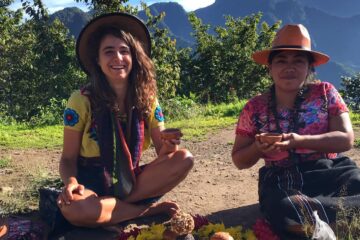
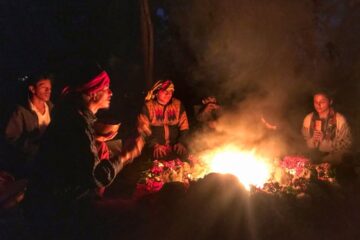

0 Comments